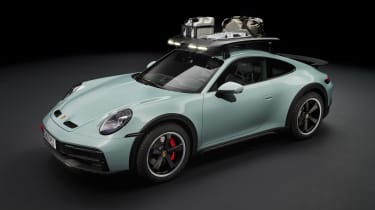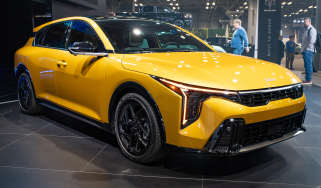New Porsche 911 Dakar receives three more heritage liveries
Porsche unveils potentially its wildest 911 to date, with plenty of nods to its rallying history
Porsche has revealed three new ‘decorative wraps’ for its new 911 Dakar - paying tribute to the car’s rally pedigree from the 1970s. Named after one of the most gruelling races on the planet, the new 911 Dakar is a bit of a step-change for the iconic sports car with a focus for off-road performance.
Currently, the two best-selling Porsche models globally are the Cayenne and Macan but even with the firm’s success in the SUV market, not many foresaw a lifted version of the 911. The off-road performance car segment could be the next big thing however with even Lamborghini recently unveiling its wild Huracan Sterrato.
The 911 Dakar will be limited to 2,500 units, and orders are now open with first deliveries expected in the UK by Spring 2023 - priced from £173,000. Only the 911 GT3 RS, Turbo S Cabriolet and Sport Classic come in at a higher price. For your money you do get arguably the most capable and eye-catching 911s of all time.
The car takes inspiration from the victory scored by the Porsche 953 in the 1984 Paris-Dakar rally. And as per the legend created by that car, the 911 Dakar is available with an optional package called the Rally Design Package, equipping the new 911 with a tribute livery.
The launch car was specified in Porsche’s ‘Rally Design Package’ which provides a not-so-subtle nod to the Rothmans-sponsored original rally car, along with a personalised start number (as long as it’s between 0 and 999). Nostalgic buyers can spec this two-tone paint for their car at £18,434.
Alternatively, three heritage wraps are now available based on Porsche’s entrants in the East African Safari Rally of 1971, ‘74 and ‘78. Beginning with the 'Rallye 1971', this fairly plain white and black design replicates the decals worn by the modified 911 S models that entered the 5,000-kilometre race for the first time in 1971. The decal set includes the number 19 - the same as the competition car which finished fifth in that year - and the complete wrap will set you back €4,165 (UK pricing hasn’t been revealed yet).
Also costing €4,165 is the ‘Rally 1974’ option which again comes in a simple white and black style. A second-place finish was achieved, courtesy of Björn Waldegård and Hans Thorszelius, despite heavy rainfall and flooding that year. The ‘Rally 1978’ option comes in at €5,950 and bears a design most motorsport aficionados would associate with Martini Racing.
While the Dakar is a bold new look for the 911 (something we haven’t said often during its 58-year existence), the powertrain is familiar. It utilises the same twin-turbocharged 3.0-litre flat six found in the current 911 GTS. It develops 473bhp and 570Nm of torque, sending power to all four wheels via an eight-speed PDK transmission. All together, it’s capable of propelling the off-road ready 911 Dakar from 0-62mph in just 3.5 seconds.
But what really makes the 911 Dakar stand out is its new stance, created via a combination of bespoke bodywork and a significantly raised ride height brought about by newly developed suspension technology.
Its standard ride-height is 50mm higher than that of a 911 Carrera S on sports suspension, but it can be raised by a further 30mm thanks to a four-corner lift system, which the brand claims enables the 911 Dakar to take part in “ambitious off-road adventures.”
The car has been extensively developed off-road, on dirt tracks, desert dunes, snow and ice, as well as on loose surfaces and of course the Nurburgring. There are standard fit all-terrain tyres wrapped around 19-inch wheels at the front, and 20-inch items at the rear are more than a nod to this new capability. However, they do mean that Porsche has felt it necessary to electronically limit the top speed of the 911 Dakar to 149mph (106mph in the fully-raised suspension mode).
In anticipation of the rougher, more physically demanding surfaces the 911 Dakar has been tasked with dispatching, it leverages the dynamic engine mounts of the GT3 model, providing a flexible and responsive level of rigidity. It also comes with rear-axle steering and Porsche Dynamic Chassis Control anti-roll stabilisation.
Along with this existing technology, Porsche engineers have developed two bespoke drive modes for the Dakar. Rally mode is claimed to be a setup idea for loose, rally-stage like surfaces, delivering a rear-biased all-wheel-drive programme. Off-road mode is specifically for maximum 4x4 capability and clearance. Both of these modes feature a new Rally Launch Control system, too.
The 911 Dakar’s body kit uses carbon-fibre reinforced plastic panels to keep the car’s weight down. At 1,605kg, it’s 10kg heavier than a Carrera 4 GTS with a PDK gearbox. The bonnet is taken from the 911 GT3, but the fixed rear wing is new, as are the wider wheel-arches, the chunky side sills, and the new front and rear bumpers complete with additional underfloor protection and stainless steel protected front grilles.
Other off-road touches include towing lugs front and rear, while the car will also be offered with an optional roof-rack with a 42kg capacity, LED lighting and a 12-volt power outlet. A roof tent option has also been developed.
The 911 Dakar is a strict two-seater, with a roll cage taking the place of the rear bench. Up front, two full-size bucket seats are equipped, while the cabin is lightly trimmed with Race-Tex surface with green stitching. Treadplates and a dashboard emblazoned with the 911 Dakar badge complete the interior makeover.
What do you think of the new Porsche 911 Dakar? Let us know your thoughts in the comments section...
Find a car with the experts












